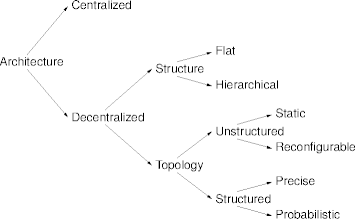Computer Networking Lecture Notes
22 November 2012 • Peer-to-Peer Architectures
Outline

Architectures
- The architecture relates the pieces to the whole.
- The purpose of each piece.
- The relation among pieces.
- Apart from organization, architectures allow
- Comparison among similar systems.
- A hook for analysis.
- Navigation through the design space.
Centralized Architectures
- A distributed architecture with distinguished pieces
- The pieces are usually called servers.
- Servers off-load specific functions from other nodes.
- Routing servers, storage servers, indexing servers, …
- Nodes needing a function contact the appropriate server.
Decentralized Architectures
- A distributed architecture with uniform nodes.
- Each node provides system services.
- Usually with help from other nodes.
- Distributed service delivery.
- Navigation (as opposed to location) becomes important.
- A single node will be most ways unsatisfactory.
Structure and Topology
- Decentralized structure measures hierarchy.
- Hierarchical structures are organized into tiers or levels.
- Flat structures are without levels.
- Decentralized topology characterizes logical relations among nodes.
- Structured topologies impose definite node relations.
- Unstructured topologies result in random (or undefined) relations.
Structured Topology
- A structured topology defines levels into which nodes are slotted.
- The placement of nodes into levels can be
- precise, always guaranteed to hold for particular nodes, or
- probabilistic, holding in general for nodes collectively.
- Structured topologies can be thought of as mappings between important system features.
Unstructured Topology
- An unstructured topology leaves everything up to the nodes to discover.
- The most important discovery are one-hop neighbors.
- Other important topological attributes follow.
- Configuration discoveries can be
- statically determined, almost a priori, or
- reconfigurable, in response to changing conditions.
Centralized Systems
- An inheritance from client-server systems.
- The servers are “thinner” in peer-to-peer systems.
- Peer-server contact tends to be brief and to establish or re-establish,
relations in the system.
- Directory servers for example.
Centralized Analysis
- Servers in a system
- Increase efficiency by reducing search.
- Focus and amortize build and run costs.
- Make network management easier.
- Unfortunately, they’re also
- Unscalable with respect to peer count.
- A single failure point.
Napster
- Napster was one of the first successful peer-to-peer systems.
- A system devoted to file sharing.
- Each Napster peer offered files for sharing.
- Peers registered file lists with the Napster server.
- A server query was a list of file names, the response was a list of hosting peers.
- The querying peer directly contacted hosting peers.
Napster Characteristics
- Unscalable and unreliable.
- The server is a bottleneck under load.
- Copyright holds had an obvious take-down target.
- Efficient and effective.
- Storage was distributed, effectively unlimited.
- Performing search was easy and fast (modulo scalability).
SETI@home
- Another early peer-to-peer success.
- A peer-to-peer system exploiting idle CPUs.
- The SETI server maintained small, well-defined computation chunks (code + data).
- Peers queried the server for work, replied to the server with results.
- Lots of other services required: peer sign-up, results checking, credit management, team organization, …
SETI Characteristics
- Unscalable and unreliable.
- The server is a bottleneck under load.
- Work storage is part of the problem.
- Efficient and effective.
- Distributed computation, effectively unlimited at an excellent price/performance ratio.
- Privacy, anonymity, and security.
- Peers are in the dark, servers aren’t.
Summary
- Peer-to-peer network architecture can be unstructured, structured, or
hybrid.
- Unstructured: arbitrary nodes and links.
- Structured: constrained links, arbitrary nodes.
- Hybrid: constrained links and nodes.
- Choices weigh between efficiency and reliability, adaptability and overhead, and others.
References
- Architecture of Peer-to-Peer Systems (Chapter 2) in Peer-to-Peer Computing by Quang Hieu Vu, Mihai Lupu, Beng Chin Ooi from Springer, 2010.
- A Survey and Comparison of Peer-to-Peer Overlay Network Schemes by Eng Keong Lua, Jon Crowcroft, Marcelo Pias, Ravi Sharma and Steven Lim in IEEE Communications Surveys and Tutorials, v. 7, n. 2, 2005.
| This page last modified on 2011 October 9. |
